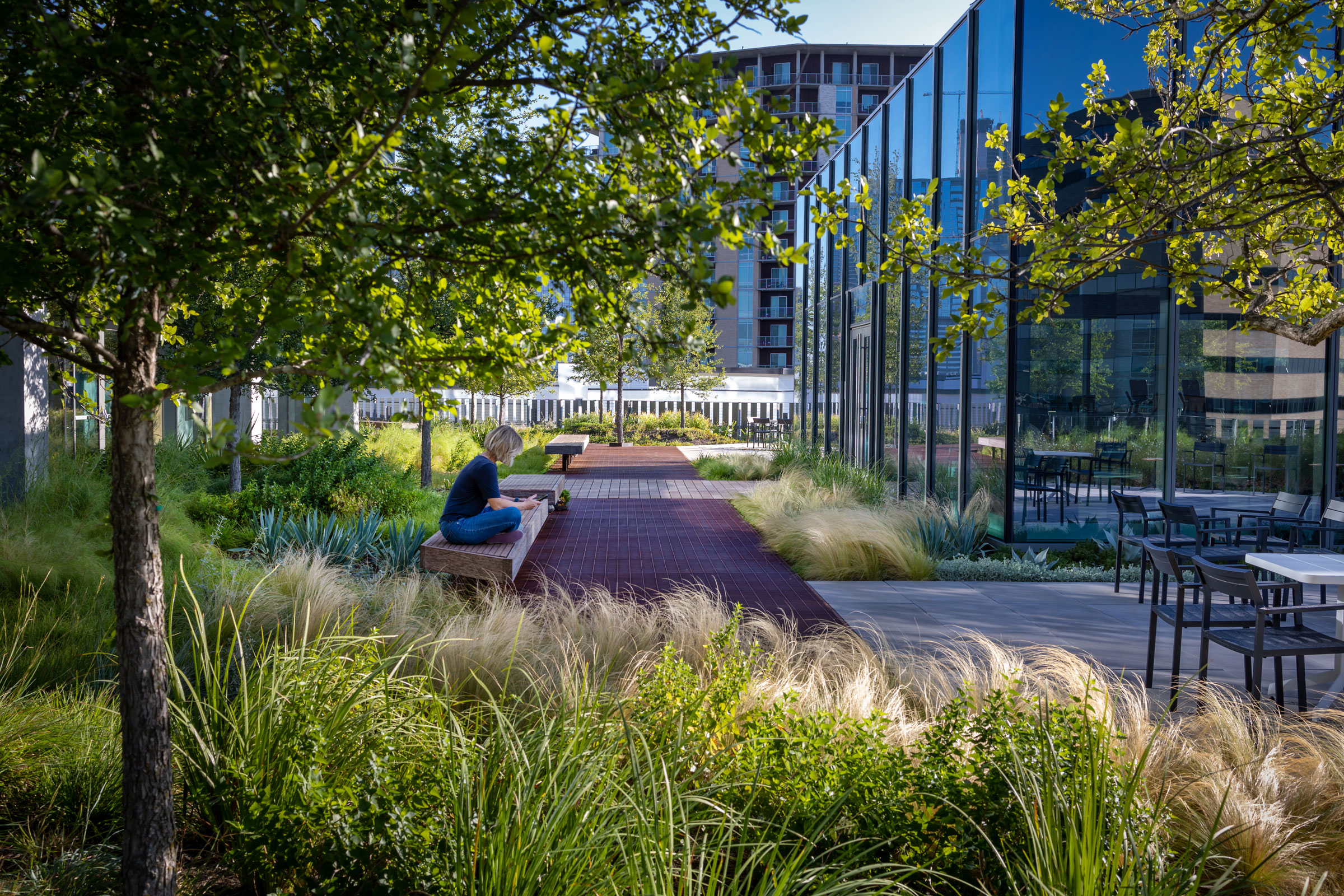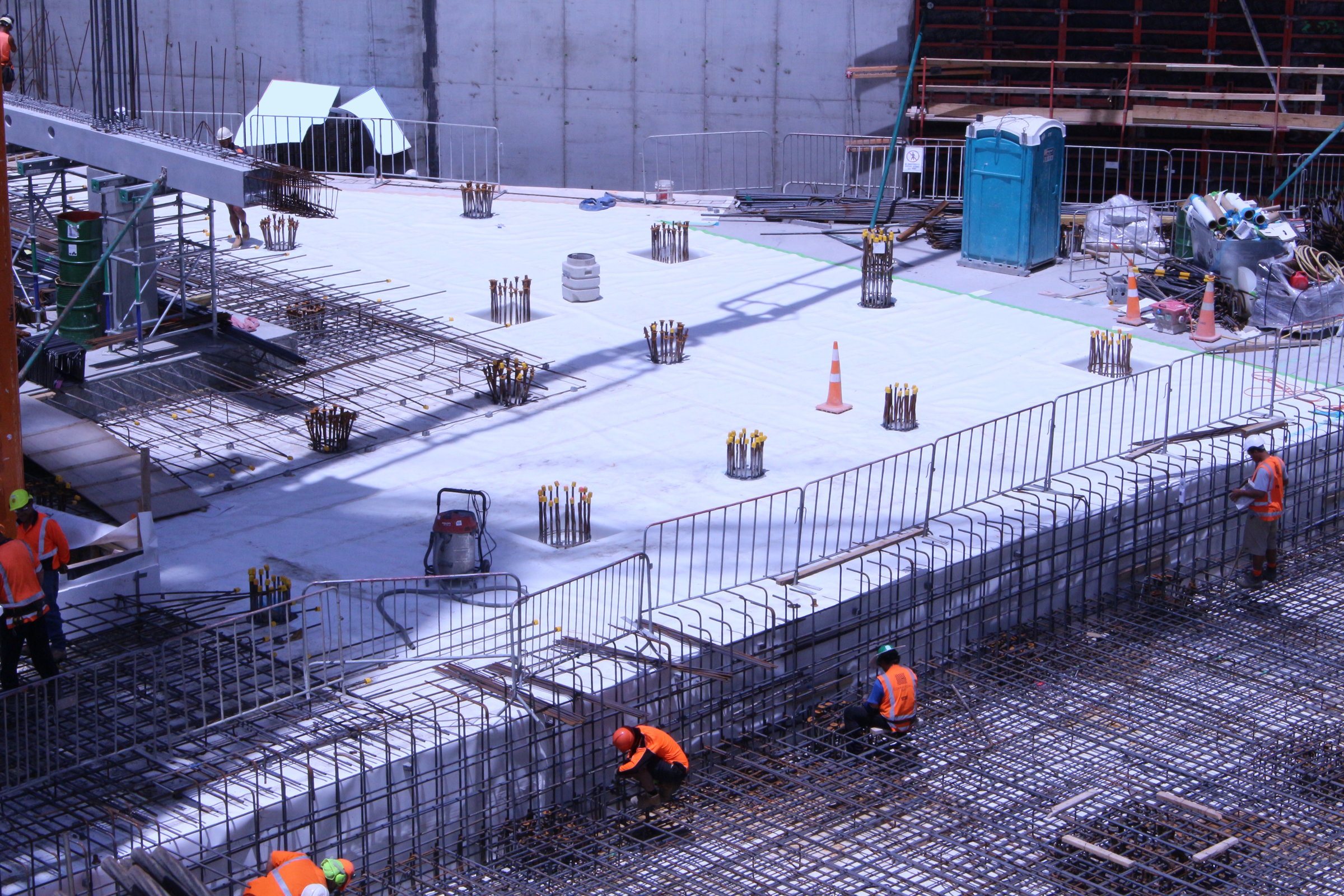Story at a glance:
- Green roofs describe any roof that is intentionally designed to support plant growth.
- Green roofs often have seven layers: a waterproofing membrane, root barrier, drainage layer, water retention layer, filter fabric, growing medium, and vegetation.
- The benefits of green roofs include stormwater mitigation, improved air quality, lower energy use and operating costs, and more.
In their most basic form green roofs—or any roof capable of supporting prolonged vegetation growth—have been around for thousands of years. It’s believed that green roofs first appeared in Scandinavia during the Viking and Middle Ages, at which point most homes featured birch bark and sod–covered roofs.
The modern engineered green roof, however, is a much more recent invention—one that traces its origins to Germany in the 1960s. Germany was the first country to start developing and marketing green roof systems. Over the next few decades green roofs would explode in popularity throughout Europe, with several countries and cities enacting policies to promote and encourage green roof installation.
It is really only within the last two decades that green roofs have gained a foothold in North American architecture, though many cities have welcomed their adoption. Some cities, like San Francisco, even require green roofs on most new construction projects.
What is a Green Roof?

Photo by Brett Ryan Studios
In the fundamental sense a green roof is any roof that has been intentionally designed to include a substrate layer that can in turn support the growth of vegetation. As a general rule most modern green roofs are comprised of seven distinct layers:
- Waterproofing membrane. Protects the roof itself and prevents water from leaking into the building.
- Root barrier. Flexible, nontoxic layer that prevents plant roots from penetrating the waterproofing membrane.
- Drainage layer. Redirects any excess rainwater not absorbed by plants or soil into a drainage system.
- Water retention layer. Allows a portion of rainwater to be stored until it is absorbed by the plants or evaporates; slows stormwater runoff and helps prevent sewers from overflowing.
- Filter fabric. Prevents soil and other organic material from washing out with the runoff.
- Substrate/growing medium. Consists of some sort of organic soil mixture or an engineered growing medium; aids in retaining water.
- Vegetation. Consists of various flora planted in the substrate (ideally those indigenous or native to the region).
Types of Green Roofs
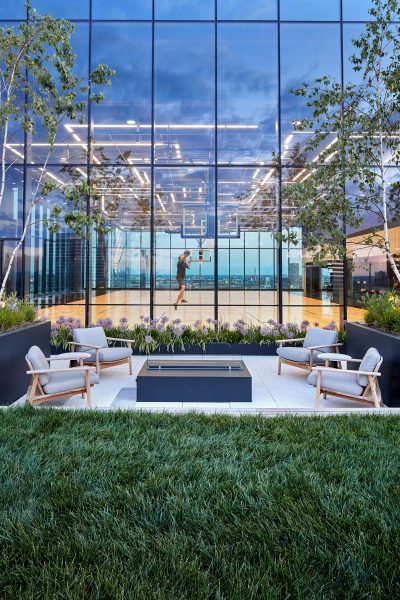
The roof deck of 167 Green Street offers views of downtown Chicago and an NBA size basketball court that opens onto a large terrace with prairie plants. Photo by Garrett Rowland
When it comes to deciding which green roof system is right for your project, there are three basic types to consider:
- Extensive. Generally designed to be as hands-off as possible, making them ideal for areas that are difficult to access or that serve no other purpose; include native plant species that are self-sustaining and capable of weathering frost, drought, and lower nutrient levels; lightweight, as soil depth rarely exceeds 6 inches.
- Semi-intensive. Requires more upkeep than extensive green roof systems, but less maintenance than intensive green roof systems; can include a wider variety of plant species; soil depth generally falls between 6 to 12 inches.
- Intensive. Akin to rooftop gardens and require frequent maintenance; opens up an almost unlimited variety of plants that can be grown, particularly those with more specialized growing conditions, including shrubs and small trees; soil depth typically ranges between 12 to 36 or more inches.
What are the Benefits of Green Roofs?
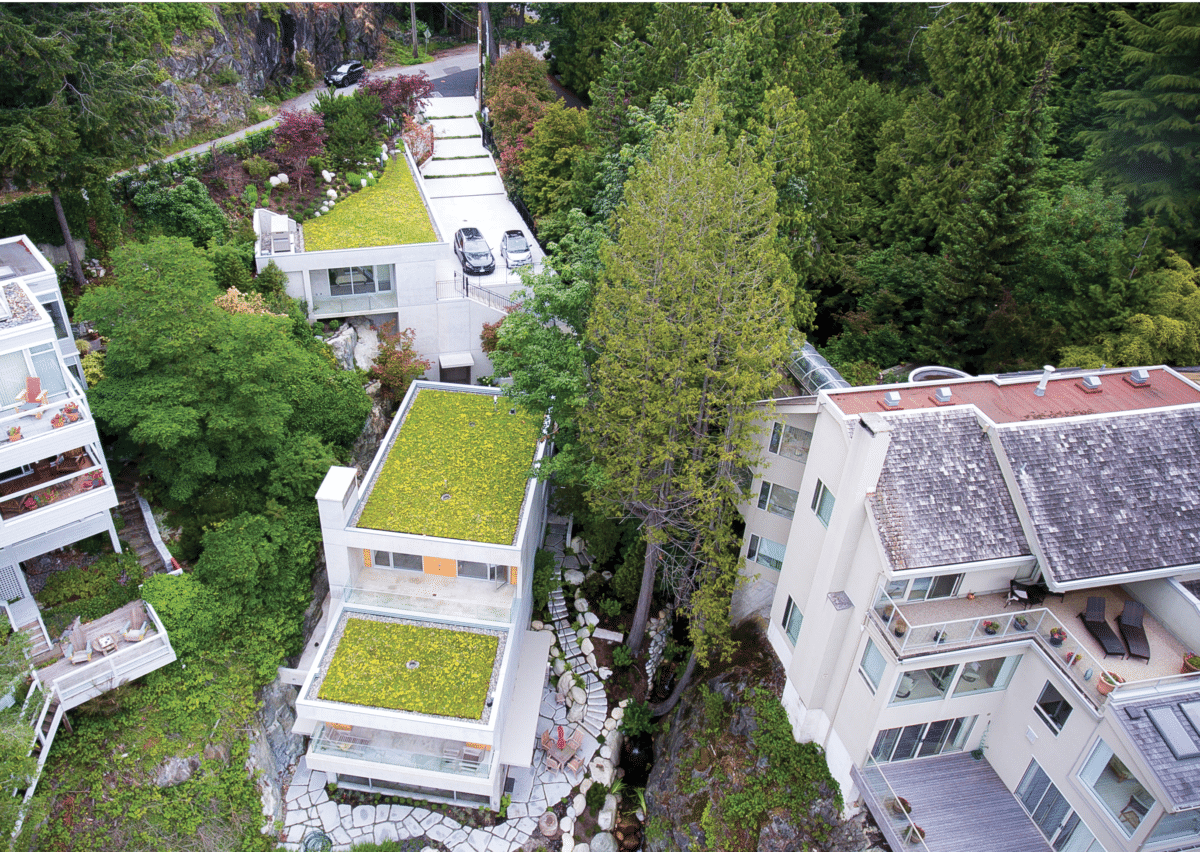
Photo courtesy of Architek
While the immediate environmental advantages of green roofs may not be surprising, there are also a range of financial and psychological benefits that come with installing green roof systems.
“Nature based solutions such as planting trees, adding green roofs and walls, maintaining natural river systems, and implementing coastal-based storm surge protection like mangroves and wetlands to combat storm surges can have a significant effect on cities,” Charlene Mortale, division vice president of project management at greenscreen, previously wrote for gb&d. “At the same time these additions provide other benefits like cooling the street level, adding pleasurable biophilic elements to our hardscapes, and making our cities livable.”
Passive Cooling & Heat-Island Mitigation
One of the most advantageous properties of green roofs is their ability to remove heat from the air—a quality that elevates their status to that of a passive cooling feature.
Green roofs provide an added layer of thermal resistance and prevent solar heat transmission through a building’s rooftop materials, thereby reducing dependency on HVAC systems for heating and cooling. On average green roofs reduce air conditioning usage by 75% and heating usage by as much as 23%. This has the added benefit of lowering a building’s overall operating costs and reducing its greenhouse gas production.
Green roofs can also help lower outdoor temperatures via evapotranspiration, thereby helping to reduce the urban heat island effect, or the phenomena by which urban areas experience higher average temperatures than rural areas. On average green roofs can be anywhere from 30 to 40°F cooler than traditional rooftops, and widespread green roof implementation can help reduce city-wide ambient temperatures by as much as 5℉, according to the EPA.
Reduce Stormwater Runoff
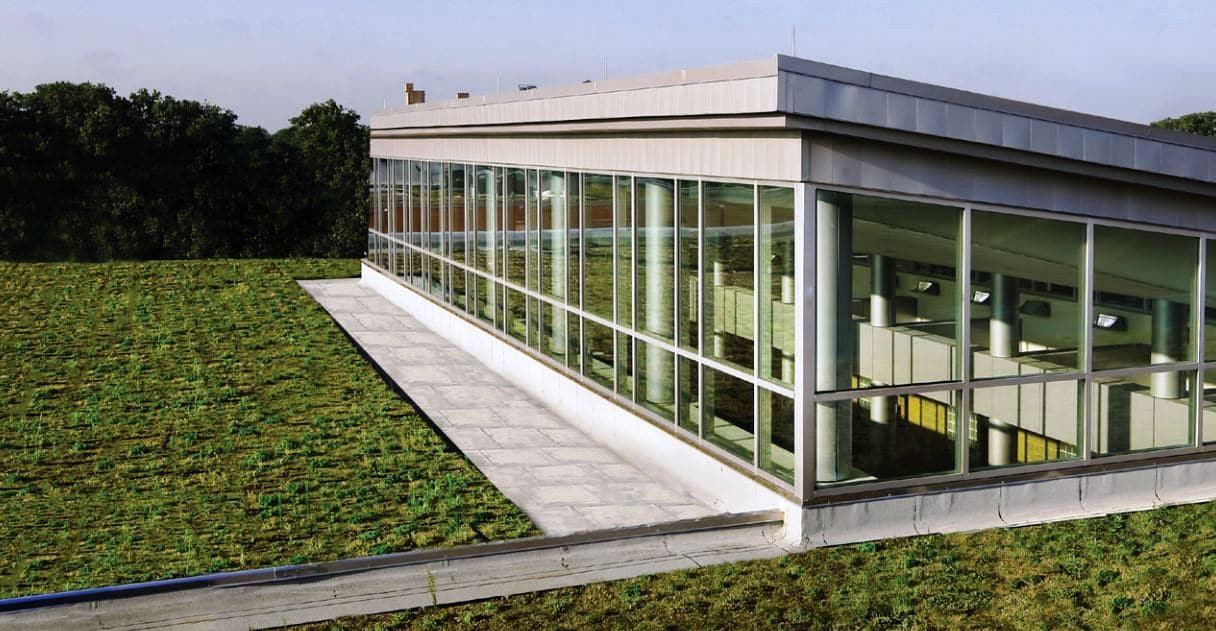
Photo courtesy of Malarkey
As climate change worsens and severe storms increase in both intensity and frequency, urban flooding is set to become an even more prevalent issue, as most cities lack sufficient measures for absorbing excess rainfall. Green roofs, however, can help.
Due to their permeable soil layer, green roofs absorb water like a sponge. Current research shows that green roof systems—even shallow extensive ones—are capable of reducing stormwater runoff by anywhere from 35.5 to 100% during any given period of rainfall, resulting in an average of approximately 68% water retention annually.
Green roofs also reduce the flow rate of stormwater runoff, which helps prevent sewer systems from overflowing and decreases the likelihood of urban flooding. On average green roofs reduce flow rate by as much as 65%, delaying runoff by up to three hours.
Any stormwater runoff that does leave the roof tends to be cleaner than that which leaves traditional roofs, as green roofs filter out pollutants and debris before redirecting stormwater runoff into sewer systems or natural waterways.
Improve Air Quality
Through a combination of fossil fuel overconsumption, increased wildfires, and rising temperatures, air pollution is becoming a serious threat to human health, particularly in urban areas. And while green roofs can’t necessarily prevent those things from happening en-masse, they can directly improve air quality in two important ways.
For starters the plants grown on green roofs are capable of absorbing carbon dioxide—the most common airborne pollutant—through their leaves before releasing oxygen as a byproduct of photosynthesis. Certain plants are also able to absorb other toxic compounds (like formaldehyde and carbon monoxide) without poisoning themselves.
These plants further improve air quality by absorbing low-altitude ozone—an inorganic molecule that creates smog when combined with certain pollutants—through the stomata in their leaves and stems. Due to their passive cooling abilities green roofs also help reduce the heating and cooling loads of buildings, meaning less energy is used and fewer fossil fuels are burned, preventing pollutants from entering the atmosphere.
Combat Noise Pollution
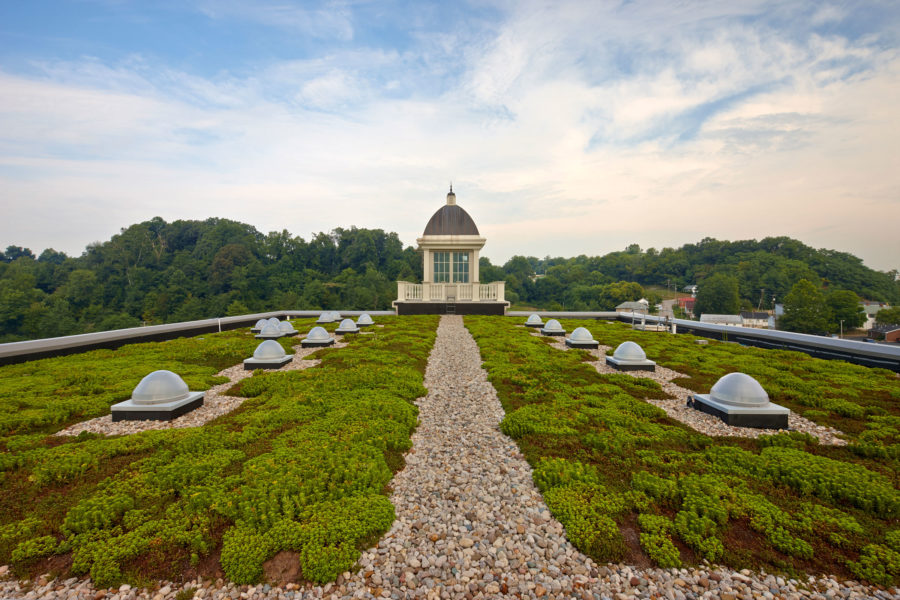
A Hancock County, Kentucky courthouse design incorporated 16 TDDs in its green roof. Photo courtesy of JRA Architects
Not only do green roofs help reduce air pollution, they also aid in combating noise pollution, fulfilling a similar role to that of standard noise-reduction panels.
Extensive green roof systems can reduce sound admittance by 20 to 30 decibels—the dense, porous substrate layer helps block lower frequencies while the vegetation itself blocks higher frequencies.
Urban Farming & Increased Food Security
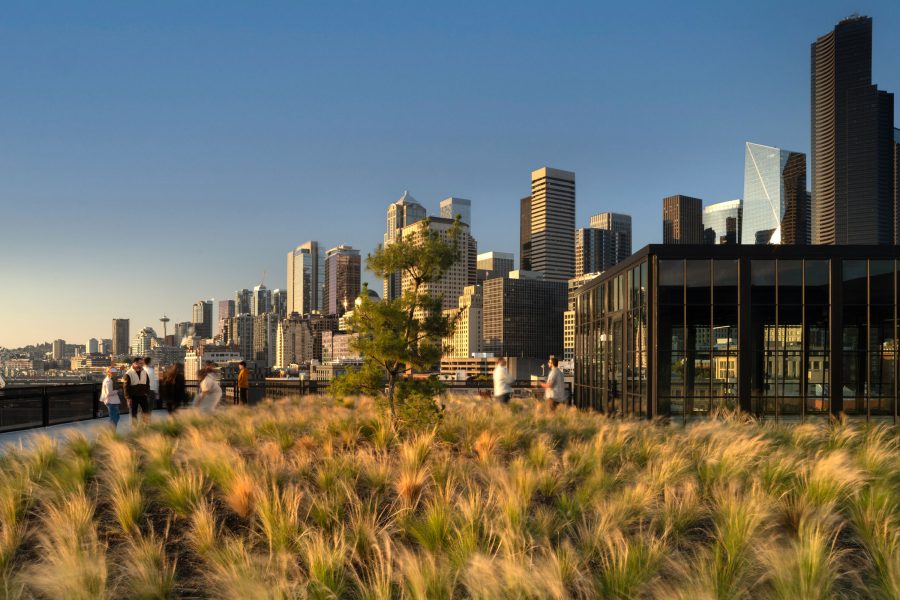
The rooftop deck at The Jack in Seattle is arranged into multiple glass pavilions focused around the central green roof. Photo by Nic Lehoux
Green roofs used for growing produce can also help increase food security, especially in so-called “food deserts,” or those communities where access to healthy, affordable food is incredibly limited.
Green roofs used for urban farming can also allow cities to increase their overall food production capabilities without contributing to further urban sprawl, providing increased opportunity for economic growth.
Enhance Psychological Well-Being
Studies have shown that proximity and access to green spaces can significantly improve one’s mental health. Most urban areas, however, have a relatively low percentage of ground-level green spaces, in large part due to poor planning and overdevelopment.
Green roofs provide a convenient means of increasing a city’s overall square footage of green space, which in turn makes it easier for citizens to connect with the natural world.
:By offering an aesthetically pleasing landscape, green roofs can reduce stress and increase worker productivity for both building residents and the occupants of nearby buildings,” Michael T. Kozak, vice president of building materials and environmental products for Minerals Technologies, previously wrote for gb&d.
Foster Biodiversity
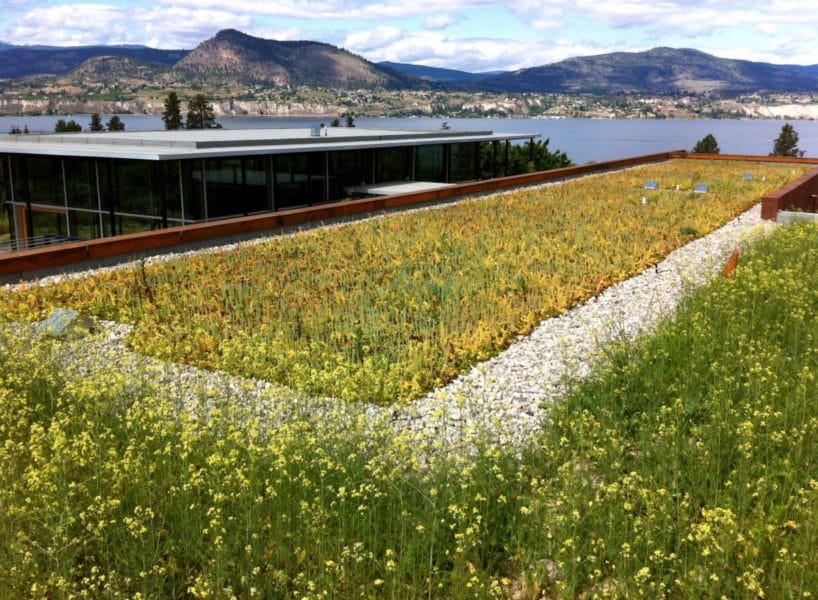
Green roof by Architek. Photo by Brett Ryan Studios
Many of today’s urban areas are severely lacking when it comes to both floral and faunal biodiversity; and while green roofs aren’t the absolute, definitive answer to this problem, they can help attract and provide habitats for vital insect and bird species as well as provide opportunities for native plant species to thrive.
What to Consider When Designing & Installing a Green Roof System
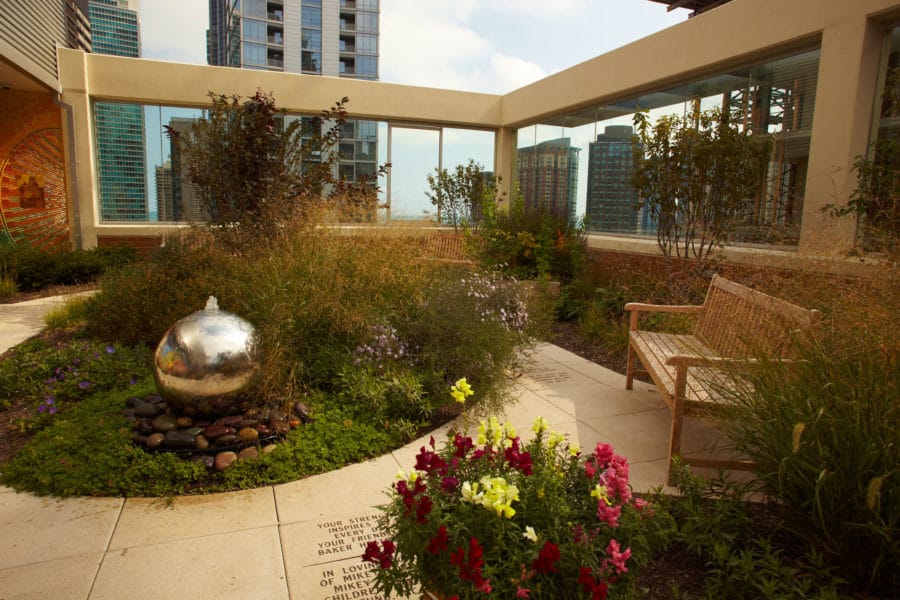
Photo courtesy of BCA Architects
From both a horticultural and architectural standpoint, green roofs are fairly complex features—which means green roofs will always need to be tailored for the project at hand.
“There’s no one size fits all approach to the green roof industry,” Ron Schwenger, a certified green building professional and principal at leading living architecture distributor Architek, previously told gb&d. “All horticultural and architectural circumstances must be taken into account.”
Exact details will vary from project to project, but in order for a green roof to be successful, the following factors should be carefully considered during the planning, design, and installation process.
Roof Pitch & Slope
For the most par green roofs can be installed on roofs of almost any pitch, including vertical or near-vertical slopes; though once you pass the 45-degree threshold, it’s more prudent to call it a living wall than a green roof. As pitch increases, green roof design generally becomes simpler, as the greater sloping reduces the risk of water penetrating the roof’s surface, which in turn means less-intensive waterproofing and drainage is needed.
In most cases, however, any pitch under 10 degrees is within the realm of what is considered normal for a green roof.
Load Capacity
When it’s all said and done, soil is a heavy material—and waterlogged soil is even heavier. When designing a green roof, it is necessary to figure out how much weight it will add to the roof via the growing medium, retained water, vegetation, equipment, pavers, etc. in order to ensure that it does not exceed the structure’s overall load capacity.
Extensive green roofs are typically the lightest type of green roof and weigh between 10 to 30 pounds per square foot, whereas intensive roofs are the heaviest and support anywhere from 50 to 100+ pounds per square foot, depending on soil depth.
The greater the weight the more structural reinforcement is required to safely support the roof. Extensive green roofs are best suited for lightweight, low-rise structures and are the easiest to retrofit without having to make extensive structural upgrades. Semi-intensive and intensive green systems require more support and are thus better suited to concrete or heavy-steel structures.
Manufacturing & Installation
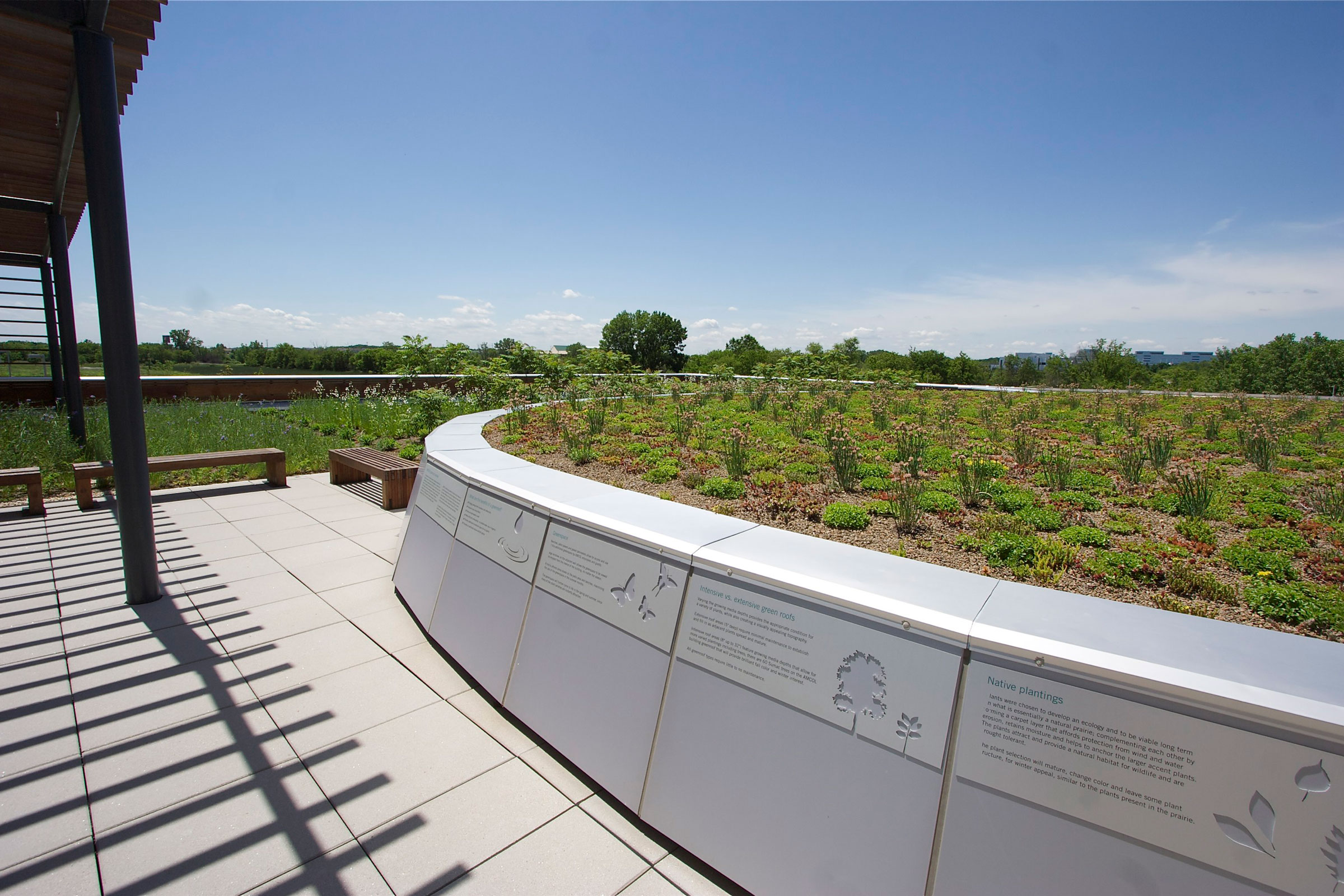
Photo courtesy of Callison RKTL
While it is possible to design and install a green roof without the aid of industry professionals, it is generally recommended that you entrust the manufacturing and installation process to a company that specializes in engineered green roof systems.
Sika Sarnafil, for example, is an international roofing company that has made a name for itself in the green roofing business.
“We have been designing and constructing plaza decks and rooftop spaces that incorporate green areas for decades,” John Robinson, Sika Sarnafil’s Education, Waterproofing, and Healthcare Facilities Specialist, told gb&d in a previous interview. “The European model of more lightweight, shallow soil, easier to maintain extensive systems have been gaining popularity in the U.S. in the past decade due to cost and design advantages.”
Similarly, Mineral Technologies’ CETCO unit offers a comprehensive green roofing solution in the form of GreenScapes, a customizable green roof system that can be tailored for extensive or intensive use. All of the integral components of GreenScape’s green roofs—including waterproofing membranes, root barriers, water retention layers, and even the growing media itself—can be conveniently obtained through CETCO.
Waterproofing
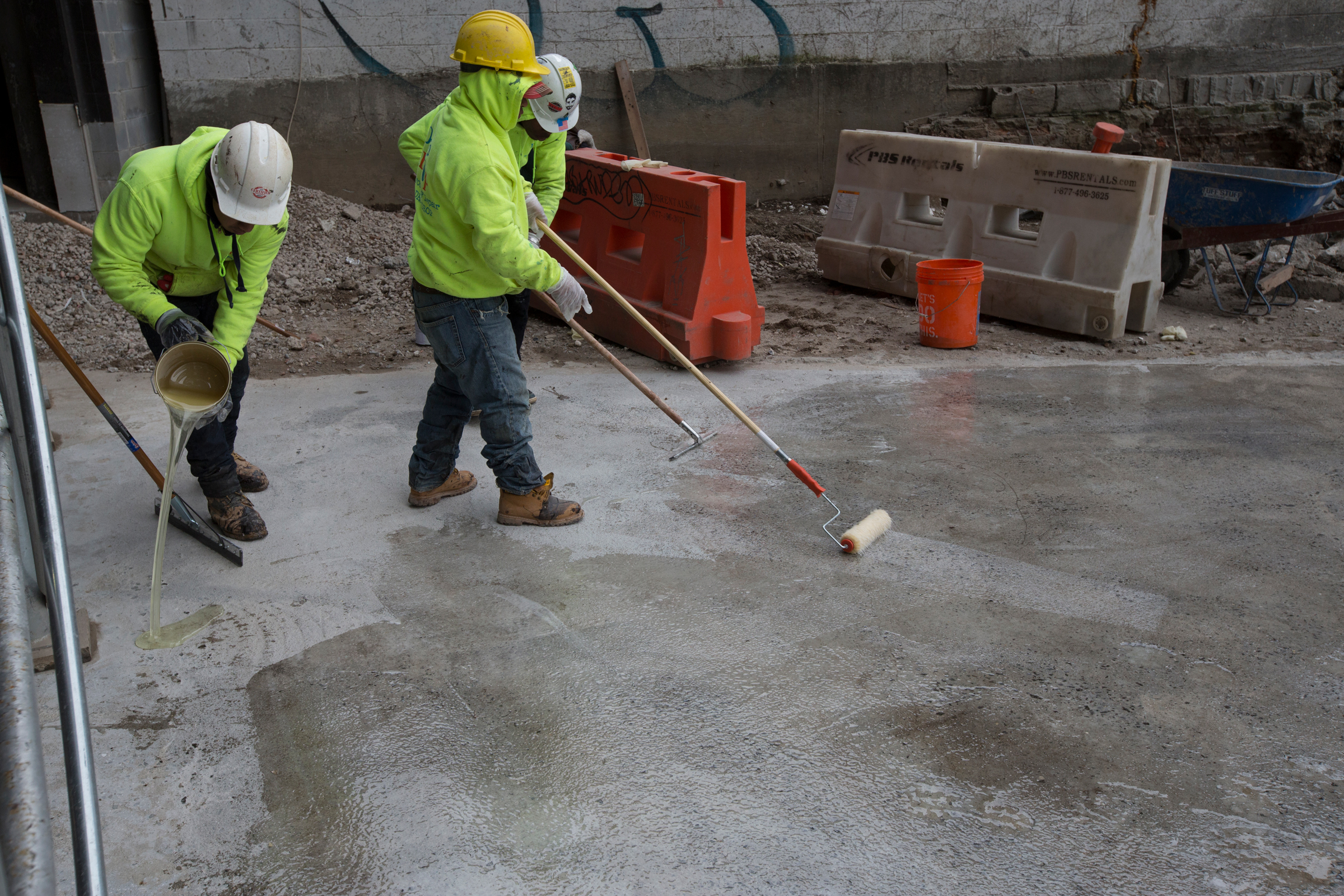
GCP’s SILCOR line of cold-applied liquid waterproofing is ideal for use with green roofs as it protects against both water and root penetration. Photo courtesy of GCP
One of the single most important components of a green roof is its waterproofing layer. Without this layer water is liable to seep into the roof itself, leading to moisture damage that could, over time, jeopardize the roof’s structural integrity. This is why it’s important to source a high-quality waterproofing membrane from a trusted, reliable company, such as GCP Applied Technologies.
As one of the world’s leading manufacturers of specialty construction chemicals and building materials, GCP offers high-quality waterproof membranes suitable for use with a variety of green roof systems. Their SILCOR 900MP and SILCOR 900HA cold-applied liquid waterproofing membranes, for example, are both extremely durable, high-strength membranes that can help prevent even the most intensive green roofs from leaking—while also providing protection against invasive root growth.
“With green roofs and planters you have vegetation and soil on top of the waterproofing membrane. As a result the membrane must be able to resist plant root growth that could be potentially damaging and diminish its protection of the surface below,” Lynn Connors, global marketing manager for GCP Applied Technologies, previously wrote for gb&d. “The chemistry of the material in cold-applied liquid waterproofing has been tested and found to naturally function as a necessary root barrier for green roofs and planters.”
Water Retention

Zauben offers customized green roof systems. Photo courtesy of Zauben
Water retention is one of the many benefits of green roofs, as this helps control stormwater runoff and aids in preventing urban flooding. Retention is achieved in part by the growing medium itself, which will naturally store some water until it evaporates or is absorbed by the plants’ roots, but it can be made even more efficient by the addition of a water retention layer or membrane.
Water retention membranes come in a variety of forms, but typically consist of either felt geotextile mats or molded plastic sheets of alternating cups and drain holes—with regard to the latter, some water flows out through the drainage holes while the cups capture and store excess water, providing the plants with small reservoirs that may be drawn upon when necessary.
Drainage
That said, green roofs do need to drain water, as too much water can jeopardize the roof’s load capacity and lead to root rot. Typically we think of a roof’s drainage ability as its ability to move water downwards, but flat roofs—especially green ones—also need to be able to move water laterally. An effective drainage system will be tailored to suit the specific needs of the green roof.
Green roof drainage systems can also be integrated with the water retention layer for maximum efficiency.
Substrate & Growing Medium
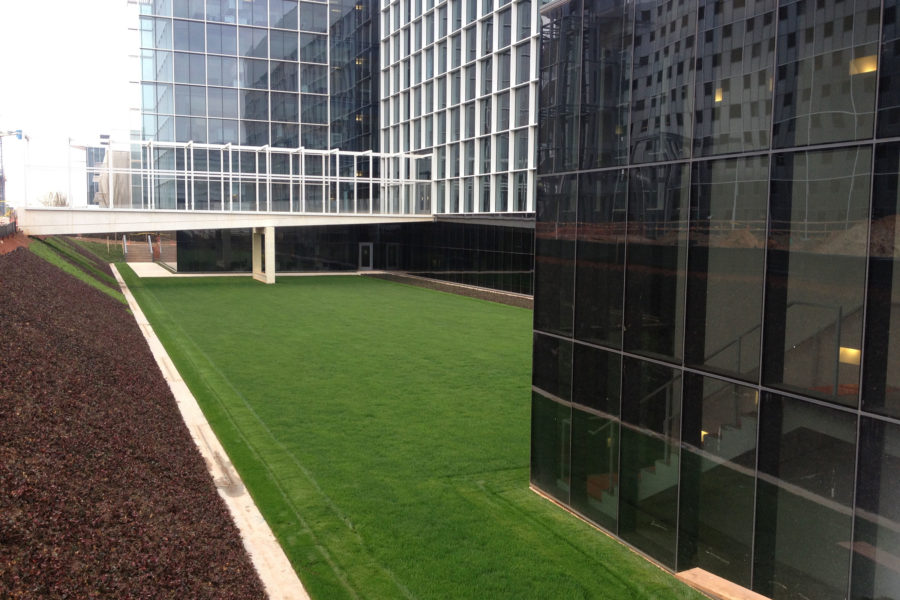
Photo courtesy of BCA Architects
One place where green roofs often fail is with regard to the growing medium itself. If the substrate mixture is of poor quality, is too shallow, or lacks the nutrients necessary to support plant life, it will be difficult for vegetation to flourish and may end up becoming more trouble than it’s worth.
For this reason it is recommended that an expert be consulted to determine the best substrate blend for your project’s green roof. This will ensure that the mixture drains well while still retaining adequate moisture, is light enough not to add unnecessary weight but heavy enough not to blow away, and is composed of the proper ratio of organic-to-inorganic materials.
Most green roof substrate mixtures contain less than 20% organic material (e.g. compost, pine bark, sorghum moss) as those substances have a tendency to become hydrophobic and slump over time. Soil with a high-concentration of organic material also poses a greater fire hazard. As a result, inorganic materials—such as ash, pumice, and sand—typically make up the majority of a green roof’s growing medium.
Hardiness Zone & Proper Plant Selection
Perhaps even more important than choosing the correct substrate mixture, however, is making sure that you select the proper plants for your project’s climate. In North America, suitable plant species can be determined by referencing a regional Plant Hardiness Zone map, which divides the continent into seven unique horticultural zones—1 being the harshest and 7 being the most mild.
As a general rule, the most successful green roofs will be those seeded with plants native to the region. Extensive green roofs should make use of indigenous grasses, sedges, and moss, while semi-intensive green roofs can typically support the same as well as native perennials, herbaceous plants, and even small shrubs.
Intensive green roofs have a virtually unlimited selection of plants to choose from, though it’s still recommended to choose those suited for the hardiness zone.
Maintenance & Upkeep
As previously mentioned, the three types of green roofs require varying levels of external maintenance and upkeep in order for them to be successful. Extensive green roofs are generally designed to be self-sustaining and so require the least amount of maintenance. In most cases they only need to be serviced two to four times a year.
Semi-intensive green roofs, on the other hand, require moderate maintenance and may need additional irrigation on occasion. Intensive green roof systems require frequent maintenance—such as weeding, watering, trimming, clearing dead brush, etc.—throughout the year, similar to a traditional garden or lawn.
In any case maintenance is required for all types of green roofs, which means care should be taken to ensure it is easily accessible via ladder, hatch, or stairwell.
Green Roof Examples
Now that we’ve a better understanding of the different types of green roofs and their benefits, as well as a few of the major design considerations, let’s take a look at a few projects that have successfully implemented green roofs in their design.
Green Square Complex
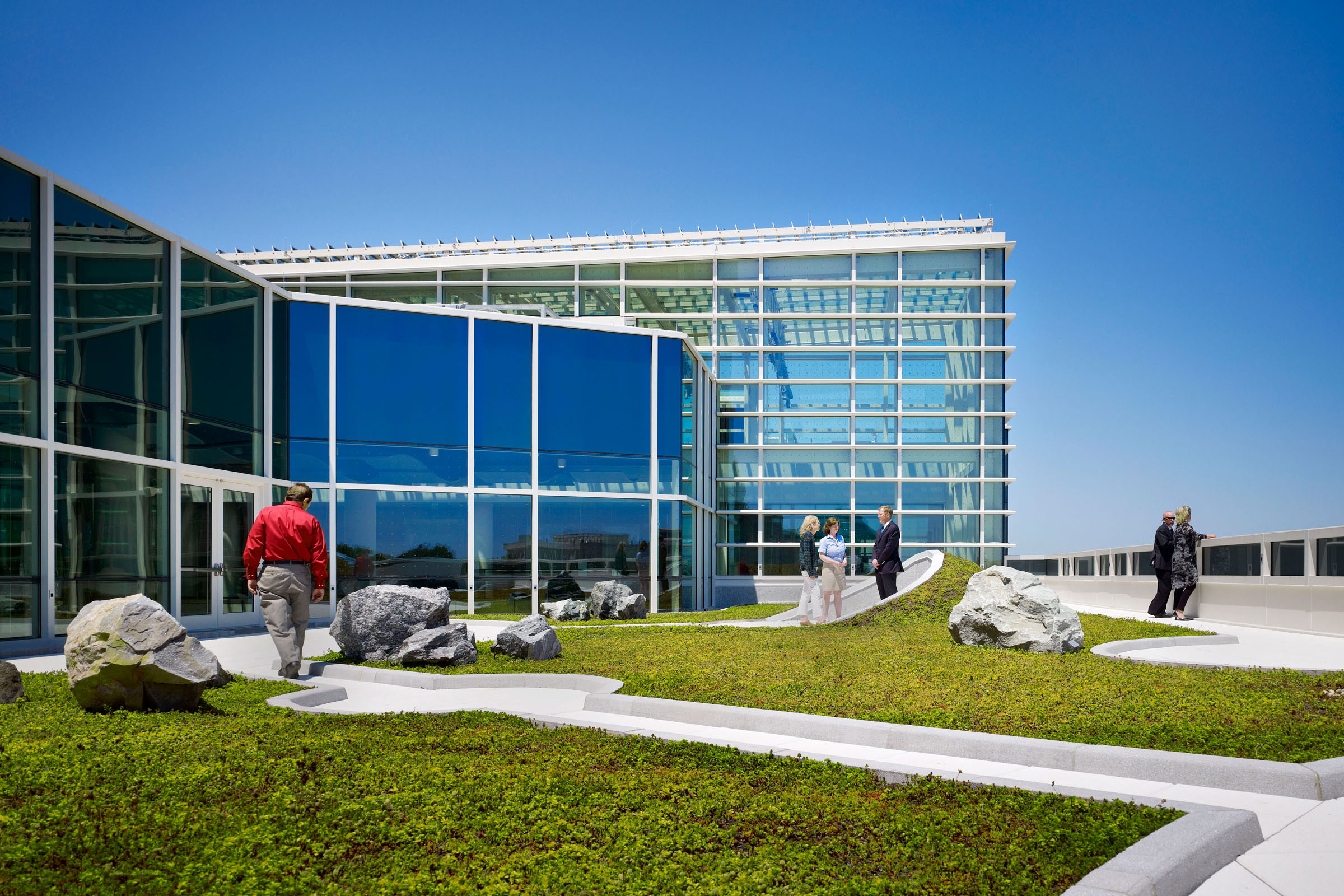
Fentress Architects designed the LEED Platinum Green Square Complex in Raleigh, North Carolina to include a 10,000-square-foot green roof. Photo by Nick Merrick
In Raleigh, North Carolina and designed by Fentress Architects, the Green Square Complex is a LEED Platinum–certified mixed-use project that encompasses two blocks and features an impressive 10,000 square-foot green roof. This roof supports a variety of native and adaptive plants that help passively cool the building and its surroundings, reducing the intensity of the heat island effect.
The Green Square Complex’s green roof also maximizes stormwater retention—in both the substrate itself and through the use of rainwater cisterns—to virtually eliminate stormwater runoff, the number one cause of water pollution in North Carolina.
Chicago City Hall
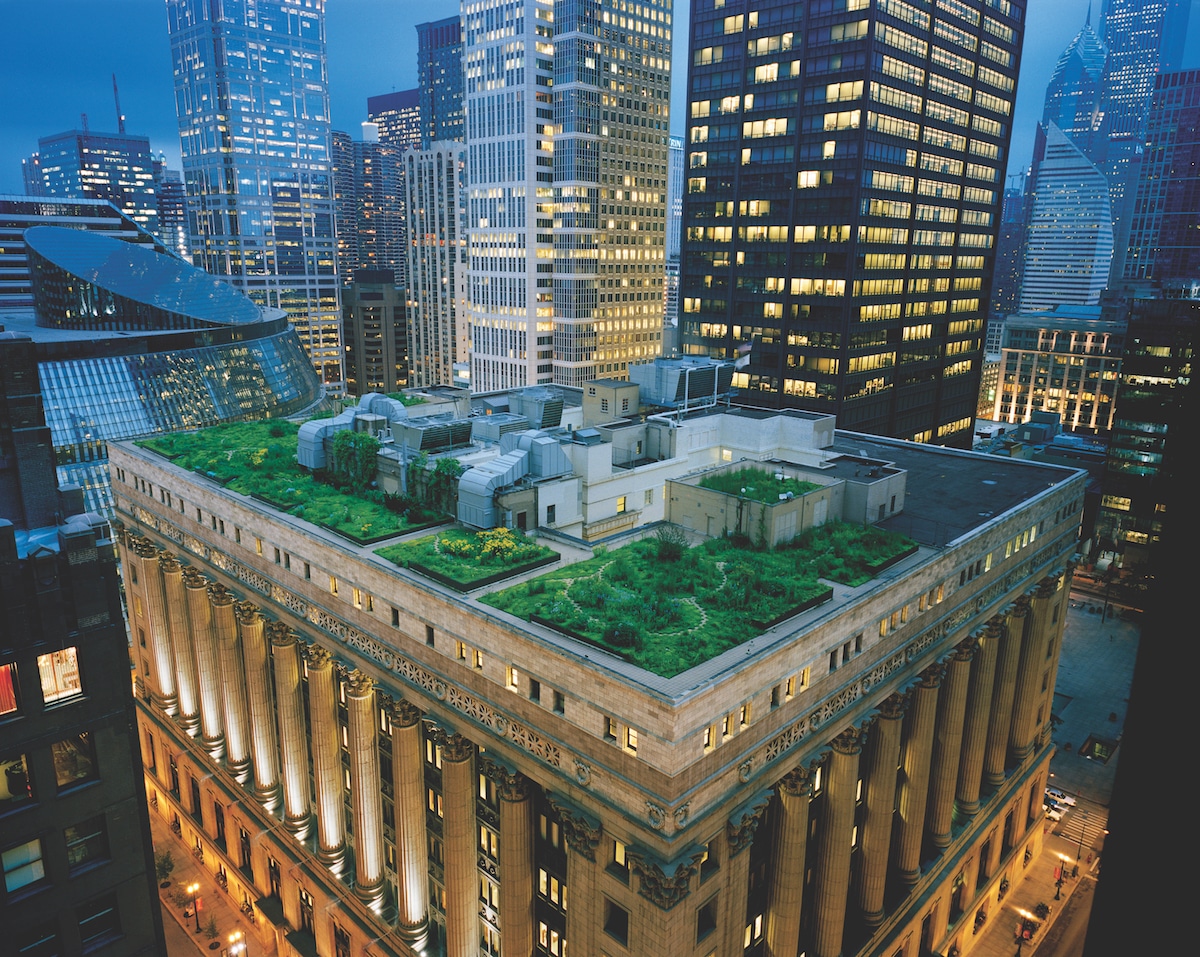
A green roof on Chicago’s City Hall. Photo courtesy of Sika Sarnafil
Installed by Sika Sarnafil in 2000, Chicago City Hall’s green roof was a demonstration project for the city’s Urban Heat Island Initiative and served to test the overall effect of green roofs on temperature and air quality. Due to its success, green roofs have been adopted by other buildings throughout the city over the last two decades.
Consisting of approximately 20,000 plants over more than 150 species, the Chicago City Hall’s green roof features a wide assortment of vines, shrubs, grasses, perennials, herbaceous plants, and even two trees, many of which are native to the Chicago region.
As is the case for all green roofs, the Chicago City Hall’s aids in improving air quality, reducing indoor and outdoor temperatures, and mitigating stormwater runoff—in fact, it’s estimated that the roof retains 75% of each inch of rainfall, greatly reducing its contribution to the city’s sewer system.
Lumen Detroit

The Lumen Detroit restaurant in Beacon Park features a cantilevered green roof deck. Photo by Jason Keen
Designed by architect Theodore Touloukian, the Lumen Detroit restaurant in downtown Detroit’s Beacon Park features a humble—though not unimpressive—green roof system.
Accessible via the restaurant’s grand staircase, Lumen Detroit’s green roof deck is of the extensive variety, requiring minimal maintenance throughout the year. Lumen’s green roof and flexible glass walls allow the restaurant to meld almost seamlessly with the park landscape, fostering a greater connection to the area itself.

